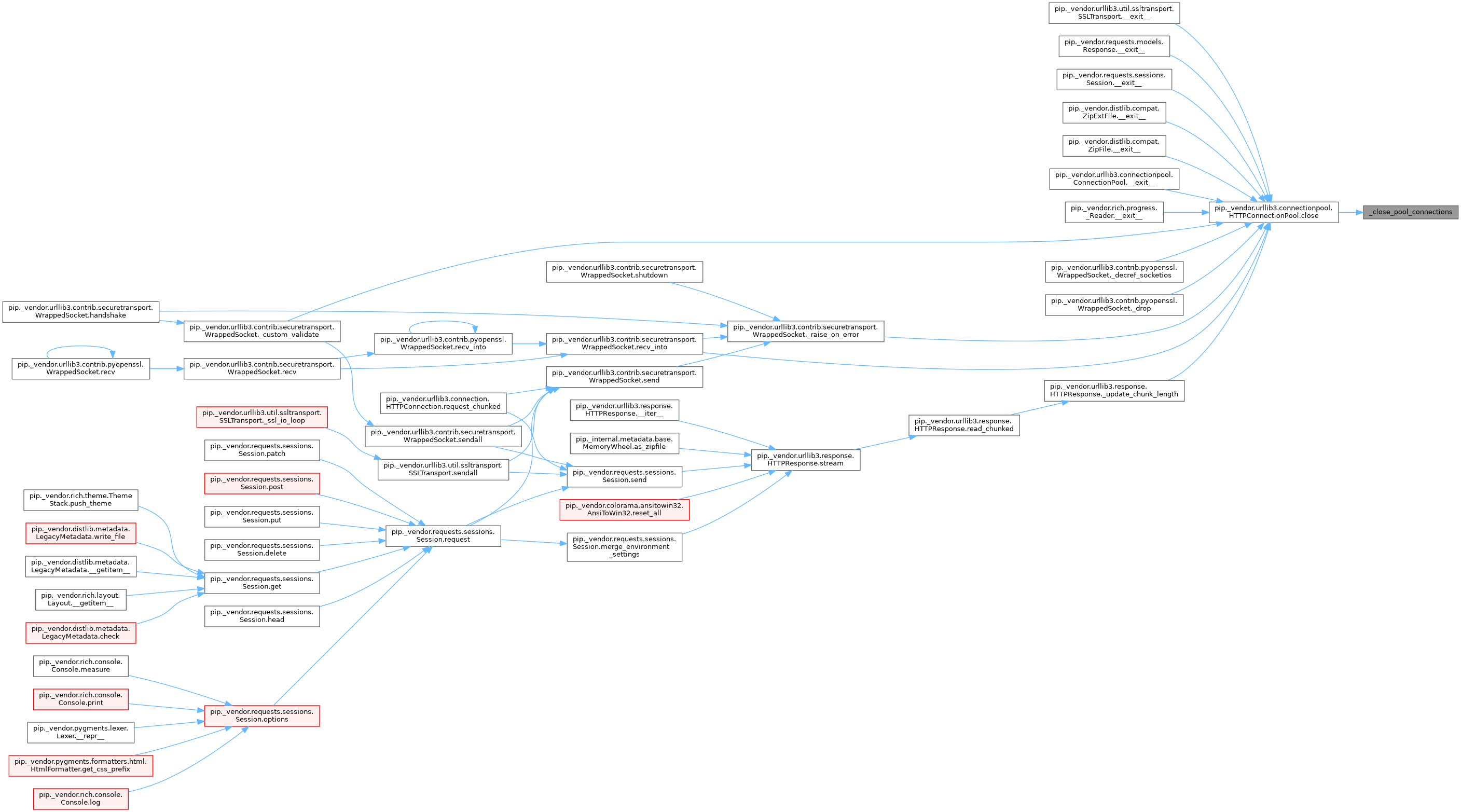Loading...
Searching...
No Matches
pip._vendor.urllib3.connectionpool Namespace Reference
Data Structures | |
| class | ConnectionPool |
| class | HTTPConnectionPool |
| class | HTTPSConnectionPool |
Functions | |
| connection_from_url (url, **kw) | |
| _normalize_host (host, scheme) | |
| _close_pool_connections (pool) | |
Variables | |
| weakref_finalize = weakref.finalize | |
| xrange = six.moves.xrange | |
| log = logging.getLogger(__name__) | |
| _Default = object() | |
| dict | _blocking_errnos = {errno.EAGAIN, errno.EWOULDBLOCK} |
Function Documentation
◆ _close_pool_connections()
|
protected |
Drains a queue of connections and closes each one.
Definition at line 1124 of file connectionpool.py.
1124def _close_pool_connections(pool):
1125 """Drains a queue of connections and closes each one."""
1126 try:
1127 while True:
1129 if conn:
1130 conn.close()
1132 pass # Done.
References i.
Referenced by HTTPConnectionPool.close().
Here is the caller graph for this function:

◆ _normalize_host()
|
protected |
Normalize hosts for comparisons and use with sockets.
Definition at line 1106 of file connectionpool.py.
1106def _normalize_host(host, scheme):
1107 """
1108 Normalize hosts for comparisons and use with sockets.
1109 """
1110
1111 host = normalize_host(host, scheme)
1112
1113 # httplib doesn't like it when we include brackets in IPv6 addresses
1114 # Specifically, if we include brackets but also pass the port then
1115 # httplib crazily doubles up the square brackets on the Host header.
1116 # Instead, we need to make sure we never pass ``None`` as the port.
1117 # However, for backward compatibility reasons we can't actually
1118 # *assert* that. See http://bugs.python.org/issue28539
1120 host = host[1:-1]
1121 return host
1122
1123
References i.
◆ connection_from_url()
| connection_from_url | ( | url, | |
| ** | kw | ||
| ) |
Given a url, return an :class:`.ConnectionPool` instance of its host.
This is a shortcut for not having to parse out the scheme, host, and port
of the url before creating an :class:`.ConnectionPool` instance.
:param url:
Absolute URL string that must include the scheme. Port is optional.
:param \\**kw:
Passes additional parameters to the constructor of the appropriate
:class:`.ConnectionPool`. Useful for specifying things like
timeout, maxsize, headers, etc.
Example::
>>> conn = connection_from_url('http://google.com/')
>>> r = conn.request('GET', '/')
Definition at line 1078 of file connectionpool.py.
1078def connection_from_url(url, **kw):
1079 """
1080 Given a url, return an :class:`.ConnectionPool` instance of its host.
1081
1082 This is a shortcut for not having to parse out the scheme, host, and port
1083 of the url before creating an :class:`.ConnectionPool` instance.
1084
1085 :param url:
1086 Absolute URL string that must include the scheme. Port is optional.
1087
1088 :param \\**kw:
1089 Passes additional parameters to the constructor of the appropriate
1090 :class:`.ConnectionPool`. Useful for specifying things like
1091 timeout, maxsize, headers, etc.
1092
1093 Example::
1094
1095 >>> conn = connection_from_url('http://google.com/')
1096 >>> r = conn.request('GET', '/')
1097 """
1098 scheme, host, port = get_host(url)
1100 if scheme == "https":
1101 return HTTPSConnectionPool(host, port=port, **kw)
1102 else:
1103 return HTTPConnectionPool(host, port=port, **kw)
1104
1105
References i.
Variable Documentation
◆ _blocking_errnos
|
protected |
Definition at line 109 of file connectionpool.py.
◆ _Default
|
protected |
Definition at line 64 of file connectionpool.py.
◆ log
| log = logging.getLogger(__name__) |
Definition at line 62 of file connectionpool.py.
◆ weakref_finalize
| weakref_finalize = weakref.finalize |
Definition at line 56 of file connectionpool.py.
◆ xrange
| xrange = six.moves.xrange |
Definition at line 60 of file connectionpool.py.